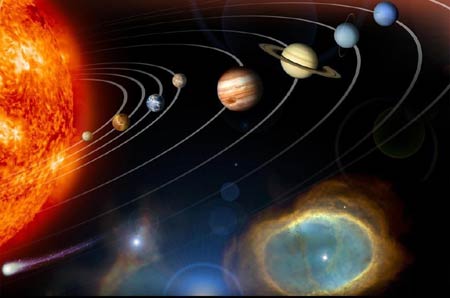|
 A planetary alignment is a rare spectacular event that has always been a topic of great interest and speculations. Some predict the end of the world, others see the start of a new golden era. This May the world will witness the alignment of six planets, with May 11 being the best out of all. |
|
A planetary alignment is a rare spectacular event that has always been a topic of great interest and speculations. Some predict the end of the world, others see the start of a new golden era. This May the world will witness the alignment of six planets, with May 11 being the best out of all. Every morning in May the naked eye will be able to spot Mars, Jupiter, Venus and Mercury, and with a small telescope one can see Uranus and Neptune. 30 minutes before sunrise, the morning sky will show all the planets aligned across the sun’s path, except Saturn. The planets line up was expected on December 21, 2012, that’s when fortune tellers predicted the end of the world and scientists awaited a spectacular show in the sky. However modern equipments and tools have showed that in 2012 no alignment will occur. Instead, a visible alignment will be seen throughout the entire month of May. For the past two months Mars, Jupiter, Venus, Mercury, Uranus and Neptune were not visible because of their location behind the sun, but starting May all planets started to line up above the rising sun. The best morning for the largest and tightest conjunction of planets this century is May 11th. That's when the two brightest planets in our own solar system, Venus and Jupiter, will almost unite. Uranus and Neptune will be shining green but will need a good binocular to be seen. "The very closest grouping will come Tuesday, May 10, when Venus, Jupiter and Mercury will be in a very close-knit triangle, with Mars to the left and below the triangle. Then on Wednesday May, 11, Jupiter, Venus and Mercury will be in a very straight line", said David L. DeBruyn. On May 13th, Mercury, Venus and Jupiter will form a "bright celestial triangle", and on May 20th, a new triangle will form. The show will end on May 30th, when the moon will join the four planets, and five "heavenly lights" will be seen at once in the morning sky. Planetary conjunctions are rare events, therefore people who have the chance to enjoy the changing alignment of the planets every day in May, should not waste the chance. No worries, it doesn't mean that the world is ending. Interesting is how the doomsayers' predictions never seem to come true. (Read by Nelly Min. Nelly Min is a journalist at the China Daily Website.) (Agencies) |
行星连成一线这种罕见奇观一直是人们关注和争相猜测的焦点。有人认为这预示着世界末日,有人则认为这预示着一个新的黄金时代的到来。今年五月世界将目睹“六星连珠”的奇观,5月11日是观看这一景观的最佳日期。 在五月期间,人们每天早晨都可以用肉眼看见火星、木星、金星和水星,用小型望远镜还可以看见天王星和海王星。在日出30分钟前,在清晨的天空可以看见各大行星排列在太阳路径上(土星除外)。 曾有人预测行星连珠会在2012年12月21日出现,科学家们期待的这一天空奇景发生时也就是算命师所预言的世界末日到来之时。然而,现代仪器的观测表明,在2012年不会发生行星连珠景观。 但是,在今年整个五月期间都可以看见明显的行星连珠景观。在过去两个月,人们都无法看见火星、木星、金星、水星、天王星和海王星,因为它们的位置正处于太阳背面。但从五月开始各大行星将太阳升起位置的上方连成一线。 本世纪行星之间最大最紧密的会合景观的最佳观测时机是在5月11日早晨。到那时我们太阳系最亮的两颗行星——金星和木星将密切会合,天王星和海王星将发出绿光,不过需要一架好的双筒望远镜才能看到。 戴维•L•狄布恩说:“行星最紧密的会合将在5月10日(周二)发生,金星、木星和水星将形成一个紧密会合的三角,火星在左边,位于三角下方。5月11日(周三)那天,木星、金星和水星将形成一条笔直的线。” 5月13日,水星、金星和木星将形成一个“闪亮天体三角”,之后在5月20日,还会形成一个新的三角。这一系列天体景观将在5月30日结束,月亮将加入这四个行星,五大“天光”将一同在早晨的天空出现。 行星连珠是罕见的景观,因此有机会欣赏五月每日行星排列变化的人千万不要错过这一良机。不用担心,行星连珠并不意味着世界末日。有趣的是,末日预言家们的预言似乎从来没有实现过。 相关阅读 (中国日报网英语点津 陈丹妮 编辑:冯明惠) |
|
Vocabulary: alignment: arrangement in a straight line(排成直线) conjunction: the fact of stars, planets, etc. passing close together as seen from the earth 合相,(天体的)会合(两星或星与基本点间成零度的视角) binocular: 双筒望远镜 celestial: of the sky or of heaven(天空的;天上的) doomsayer: a person who says that something very bad is going to happen(凶事预示者;预言灾难者) |
